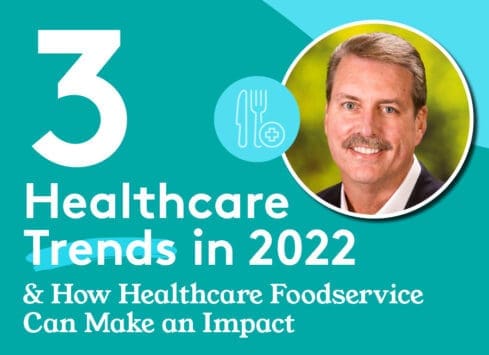3 Healthcare Trends in 2022 and How Foodservice Can Make an Impact
I spend a lot of time talking with clients and healthcare leaders across the country.
These conversations are not just about my role as CEO of Morrison Healthcare. They also serve as an opportunity to better understand the challenges we face as an industry, collectively. I believe it is important to regularly check the pulse of what is happening, so we can quickly adapt to change and help solve problems for our existing and prospective customers.
With that in mind, I identified these three healthcare trends for 2022 and how Morrison Healthcare Food and Nutrition Services is making an impact and delivering value to our hospital and health system partners.
Workforce Challenges
Businesses across the country, regardless of industry, are struggling to remain appropriately staffed, either through resignations or difficulty in hiring. On the healthcare side, it causes operational challenges and financial strain for hospitals.
Nursing has been hit particularly hard. This has led to the drastic increase of travel nursing, which grew by 35 percent in 2020 and another 40 percent in 2021. While that may fill a need, it is not a sustainable staffing model, as a travel nurse can make upwards of $5,000/week. That leaves many organizations to rethink how they handle their workforce.
On the food and nutrition services side of the business, solving the current labor challenges takes creativity along with a focus on recruitment and retention. As part of this, we focus as much on retention as we do in hiring. By retaining top talent, we create efficiencies and control labor costs.
Foodservice can be a satisfier across an organization, leading to improved retention rates across all departments in a hospital. From self-service retail check out to our Market on the Move program, we are creating opportunities for hospitals to engage with their employees.
Clinicians are under a great deal of strain. As a result, we are working with hospitals to further integrate Morrison Healthcare dietitians into the care model, giving them a larger role in addressing the patient’s nutritional needs. That was recently highlighted in our 2022 Vision Book where two dietitians took over primary responsibility for placing small bowel feeding tubes, freeing up the nursing team to tackle other patient care areas. Our sister company, Crothall Healthcare, is now offering a hospital sitter program that alleviates the strain patient sitting creates on clinical staff.
Margin Pressure
Two years of a pandemic have stretched the bottom line for hospitals. From unexpected personal protective equipment purchases to skyrocketing labor costs, hospitals are seeing their margins shrink. Average operating margins fell from 5.6% in mid-2019 to 1.5% as of Q3 2021. Some hospitals that previously turned a profit expect to operate at a loss over the next 12 months.
Going forward, it will be critical for healthcare organizations to keep tight reins on as many operational areas as possible. For instance, managing the length of stay is a prime area where hospitals will focus their efforts to maximize reimbursements. Finance and Supply Chain Departments will look for opportunities to cut costs through new synergies and contracts when possible.
In food and nutrition services, efficiency can come from many areas. As a whole, we look at the workflows of our clients. More specifically, we are developing programs that meet our clients’ needs and innovate the industry. While not an exhaustive list, here are three ways we’ve found success alleviating margin pressure.
- Redesigning Patient Menus—Streamlining menus can bring significant savings to a hospital. By condensing the food offering, hospitals gain control over food costs and create less waste. You can still meet the needs of patients and diners while lowering the quantity of inventory you hold on hand.
- Technology—Technology can also play a role in controlling operating costs and driving efficiency. Through technology, we have a great opportunity to harness data and make informed decisions. Look no further than our Waste Not 2.0 app, which has proved successful at reducing food waste and bringing new savings to healthcare organizations. We’re also making great strides with self-service technologies that reduce reliance on labor but deliver a high-quality customer experience.
- Purchasing Power—Morrison Healthcare can help lower the cost of food. We offer our clients contracts that come with significant savings through our partner food purchasing organization, Foodbuy. By working together, we can lower expenditures and improve the bottom line.
Margins may be tight but there are opportunities to decrease your operational expenses through reimagined product offerings, innovative programs, and new efficiency models. It takes creative thinking and the right partner.
Shifting Acuity
Hospitals are seeing more chronic conditions throughout the care continuum, which is increasing the length of stay and ultimately hurting the bottom line for hospitals. Just look at the past year, which saw 100,000 deaths from diabetes alone.
The cause of this uptick in chronic illnesses can be attributed to factors such as shifting demographics and rising obesity rates to name a few. COVID-19 may be partially to blame as some patients have deferred care or been unable to take care of their medical needs due to financial or other difficulties.
The shifting acuity of patients is a major problem that will define healthcare in this country for decades to come. We must embrace the power of food as medicine and educate our patients about how to live a healthy lifestyle before they present at an emergency department with a chronic condition.
That’s why Morrison Healthcare is tackling the problem head on.
Medically Tailored Meals—Chefs across our accounts are developing plans to deliver medically tailored meals to discharged patients. Most of these programs focus on food insecure individuals and are tailored to meet the therapeutic dietary needs of patients with a nutrition-related chronic disease.
Through the medically tailored meals programs, patients receive not only a number of meals per week, but also an assortment of resources and education. They learn what ingredients to pick when cooking healthy meals, as well as how to prepare the food and how to shop when they go to the grocery store.
Malnutrition—Over the past few years, Morrison Healthcare has invested heavily in malnutrition programs. These initiatives have yielded staggering results and improved patient outcomes for numerous clients. In FY21, the program enabled partner hospitals to capture $89 million in revenue based on accurate coding and subsequent billing. It has also reduced hospital stays, helping margin pressure. That is a tangible benefit that is driving change and supporting patients.
Supporting Caregivers—We are actively working to support our caregivers. Caring for those who care for us is a critical tool to support communities. Morrison Healthcare and Compass One Healthcare have partnered with the American Nurses Association’s Healthy Nurse, Healthy Nation™ initiative, which aims to improve the health of the nation by first improving the health of America’s four million registered nurses. Food is a powerful tool that can have a broad range of benefits for the health and wellbeing of nurses.
With challenges come opportunities. Hospitals have an opportunity to innovate and find new levels of efficiency that can create sustainable operations. It won’t be easy, and the stakes are high. But together, we can drive change and deliver life-changing care for our patients, caregivers, and communities.

